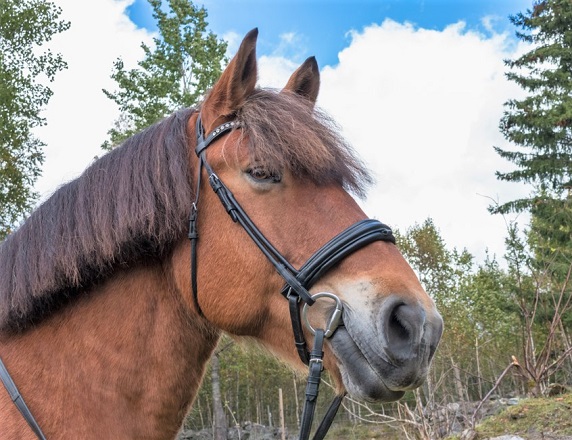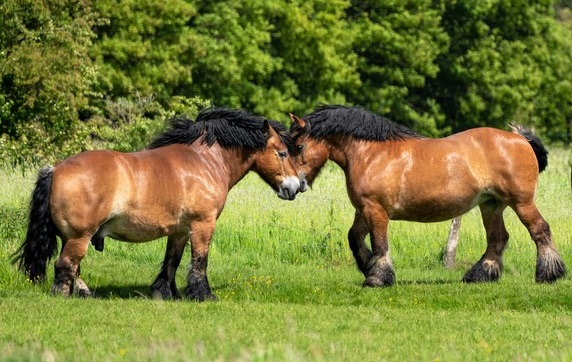The Ardennes Horse is a heavy draft breed that originates from the Ardennes region in France, Belgium, and Luxembourg. Also known as Ardennais, they are famous for their incredible strength, heavy musculature, and docile temperament.
However, the Ardennes horse didn’t always have the typical heavy-draft look. Before the 19th century, they stood much shorter and lacked the heavy bone structure of the modern breed. These early Ardennes Horses were popular war horses because of their impressive stamina and pleasant nature.
As the breed’s role shifted from war to draft work, its appearance also changed. While Ardennes Horses are not as widely known today, they represent a piece of history that shouldn’t be forgotten.
1. A Draft Horse Breed From Ancient Rome
The Ardennes Horse is one of the oldest European draft horse breeds. Early versions of the breed were allegedly bred for 2,000 years in the Ardennes area.
The ancient Romans favored the ancestors of the modern Ardennes Horse as heavy cavalry horses. Even the great Roman emperor Julius caesar spoke highly of them. The book “Commentarii de Bello Gallico” described these horses as “rustic, hard and tireless”.

tatianaput / Shutterstock.com 2. Ardennes Horses Descend From The Prehistoric Solutrian Horse
Many experts believe Ardennes Horses are direct descendants of the ice-age Solutrian Horse dating back to 50,000 BC. (Source: Viovet)
These prehistoric horses lived during the Paleolithic Age and were the original inhabitants of the Ardennes region. They are the types of horses you see on many ancient cave paintings such as the ones in Lascaux, France.
3. Various Horse Breeds Influenced The Ardennes Horse
Over the last few centuries, the Ardennes Horse changed considerably in appearance. The breed we know as a tall and heavy draft horse in the Roman era was only 14 hands high!
The role of the Ardennes Horse as an indispensable war mount persisted over most of history. Among the great rulers who loved the breed was Napoleon, who used Ardennes Horses in his Russian campaign. He added Arabian blood to the gene pool to increase the breed’s stamina and hardiness.
Other breeds that influenced the Ardennes Horse include the Thoroughbred, Percheron, and Boulonnais. However, their impact was negligible compared to the Belgian Draft Horse that was added to the breed in the 19th century.
Due to the Belgian blood, the Ardennes Horse has the heavy appearance we see today. From this point onwards, breeders focused on producing tall and powerful draft horses to meet the changing needs of society.
The Ardennes Horse was also used to improve or create other horse breeds in Europe and Asia. Among others, the Ardennes influenced the Russian Heavy Draft, Comtois, Sokolsky Horse, Trait Du Nord, and Baltic Ardennes breeds.

Margit Kluthke / Shutterstock.com 4. The First Ardennes Stud Book Dates Back To 1929
While the breed has existed for thousands of years, the first Ardennes breed registry was established in Europe in 1929. There are three separate studbooks for horses in Belgium, France, and Luxembourg. However, the requirements of each are all the same.
In the early 20th century, the first Ardennes Horses began to make their way to the United States. Imports from Belgium were ongoing until 2004. Today, several breeding farms produce quality Ardennes Horses in North America.
Also Read: 11 Interesting Facts About Percheron Horses
5. A Magnificent War Horse Breed
As you already know, Ardennes Horses were valuable assets in war throughout history. Roman emperors used them extensively as cavalry mounts, and the breed served bravely during the Crusades in the 11th century.
During the French Revolution in the late 18th century, Ardennes Horses were highly regarded as artillery horses. It’s no coincidence that Napoleon chose this breed to pull artillery and supply wagons for his 1812 Russian campaign. He knew no other horse that was hardy enough to withstand the harsh Russian winter.
Ardennes Horses also pulled artillery and supplies during the First and Second World Wars. Their service was essential to the French and Belgian armies that depended on the breed’s strength, bravery, and calm disposition.

Kevin Carvalho / Shutterstock.com 6. Ardennes Horses Can Weigh Up To 2,200 Pounds
Due to the Belgian’s influence, Ardennes Horses are among the heaviest and strongest horse breeds on the planet. They can weigh anywhere between 1,500 and 2,200 pounds (700 to 1,000 kilograms), making them about twice as heavy as the average horse.
The average height in the breed is around 15 to 16 hands, depending on the country. In France, for example, Ardennes stallions usually stand 16 hands tall, while mares average 15.3 hands. In Belgium, however, these are the maximum acceptable heights.
Also Read: Meet Brooklyn Supreme, One of the Biggest Horses in History
7. They Are Gentle Giants In Every Way
While the sheer size of Ardennes Horses might be intimidating to some, they are truly peaceful in spirit. The breed is famously calm and docile and a gentle giant in every way.
The Ardennes Horse is also very easy to handle, even by children. Its easy-going and tolerant nature makes the breed such an excellent workhorse.
8. The Ardennes Horse Is Still Used For Work Today
Although the need for draft horses declined heavily after World War II, the Ardennes horse found a place in modern society. They are becoming increasingly popular for forestry, farm, and leisure work. The breed is also famous for its surefootedness and ability to work on rough terrain.
The Swedish Ardennes is still in high demand for forestry work in Scandinavia. Once one with the Ardennes Horse breed, the Swedish Ardennes is now officially recognized as a distinct breed.

Bildagentur Zoonar GmbH / Shutterstock.com
The Ardennes Horse also excels in competitive driving disciplines other than draft work. Good stamina, nimble action, and an agreeable nature are key qualities in carriage horses that are found in the Ardennes Horse.
Last but not least, Ardennes Horses also make excellent therapy horses. In the United Kingdom, the Riding for the Disabled Association uses several Ardennes Horses in their program.
Also Read: 7 Main Uses of Horses Throughout History
9. Ardennes Horses Are Often Roan
Roan and bay are the most common colors in the Ardennes horse breed. However, they may also be gray, chestnut, or palomino. Black, on the other hand, is a very rare horse coat color and undesirable in the breed.
The Ardennes breed registry accepts white markings as long as they are small, such as a star or a blaze.
10. They Are Easy To Look After
Despite their massive size, Ardennes Horses are surprisingly economical to feed as they put on weight easily. The breed also tends to mature early and is relatively free of genetic defects and illnesses.
In horses, being a good-doer is often linked to hardiness and the ability to withstand harsh weather. The Ardennes is no different. Thanks to its thick winter coat and abundant feathering, the breed has always fared well through low winter temperatures.
Also Read:
8 Norwegian and Swedish Horse Breeds10 Horse Breeds You’ve Never Heard Of11 Interesting Facts About Paint Horses12 Extinct Horse Breeds You Never Knew Existed
Source: horseyhooves.com








